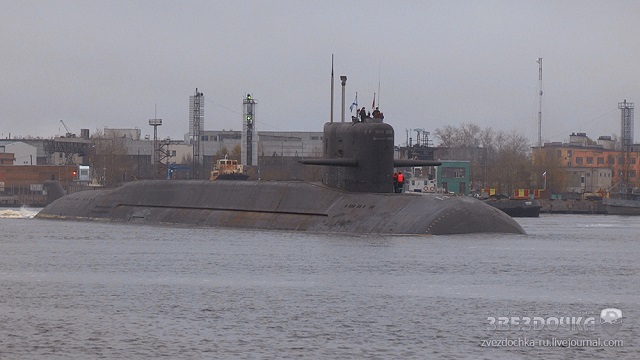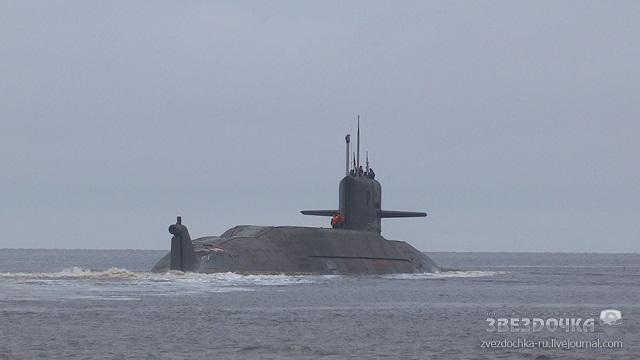 The Project 09787 BS-64 Podmoskovye special-purpose nuclear-powered submarine sailing out for its first trials at sea. Picture: zvezdochka_ru The Project 09787 BS-64 Podmoskovye special-purpose nuclear-powered submarine sailing out for its first trials at sea. Picture: zvezdochka_ru |
|||
|
Following the repair and upgrade, BS-64 departed the Zvyozdochka Shipyard in Severodvinsk and commenced her running tests. The press office of Zvyozdochka, a subsidiary of the United Shipbuilding Corporation (USC), reported the fact on October 24.
"The crew and Zvyozdochka’s delivery team will test all of the systems and mechanisms of the nuclear submarine and perform scheduled tasks to prove her design characteristics," the press office said. Thus, the Podmoskovye has put out for the first time in 16 years, with the interval being due to her conversion from the Project 667BDRM K-64 ballistic missile submarine to a carrier of minisubs - nuclear deep-water stations and unmanned submersibles. The development of the new ship was ordered by the Russian Defense Ministry Main Directorate of Deepwater Research (MDDR). The K-64 SSBN’s conversion to a minisub mother ship began in 1999. The work has been repeatedly suspended due to a requirements specification revision, a shortage of funds, you name it. Little is known about the advanced ship owing to its being a black project. The missile compartment was cut out of the hull of the SSBN and replaced with a special compartment with connectors and sluice chambers for the submarines, which carrier the Podmoskovye is now. The compartment also houses the hydronaut bay and research bay. The introduction of the new compartment has made the ship somewhat longer. At present, the Navy operates only one special-purpose nuclear-powered submarine, the Orenburg, converted from another Project 667BDR SSBN during 1996-2002. It is worth mentioning that the decision on converting two SSBNs to minisub carriers was made in the 1990s, when, after the fall of the Soviet Union, the naval leg of the Russian nuclear triad diminished in a dangerous fashion, the defense spending was slashed and the construction of advanced ballistic missile submarines was not even in the cards. Nonetheless, the country’s military-political leadership ordered two SSBNs to the shipyard and stripped of their missiles. Missiles are no longer the main armament of the Orenburg and Podmoskovye. Nevertheless, more than 10 commissioned officers with the Northern Fleet’s 29th Separate Submarine Brigade operating in support of MDDR and owning both special submarines have been awarded the Gold Medal of the Hero of the Russian Federation [the highest military decoration]. For the record: the nuclear deep-water stations to be carried by the Podmoskovye had not been in the Navy’s inventory before 1986, instead having been operated by a General Staff outfit close to the Main Intelligence Directorate (GRU). |
|||
 The Project 09787 BS-64 Podmoskovye special-purpose nuclear-powered submarine sailing out for its first trials at sea. Picture: zvezdochka_ru |
|||
|
The West has long scrutinized any information pertinent to MDDR almost under a microscope. For instance, even a mention of the Project 22010 Yantar Kryuis-class survey vessel by the media creates quite a stir, because she is with MDDR too. In early October, the foreign press was actively speculating about "the secret and suspicious activities" of the Yantar in the areas, through which international communication cables run in the Eastern Mediterranean close enough to Syria’s coast.
Presumably, BS-64 is designed for carrying Kashalot, Paltus or Losharik nuclear deep-water stations. Their modus operandi is as follows: the carrier brings a nuclear deep-water station - a low-speed minisub - to the assigned area covertly and then releases it. According to open sources, the Podmoskovye will carry a Klavesin-1R self-contained unmanned submersible as well. The nuclear-powered minisub best known to the media is the Project 10831 AS-12 dubbed Losharik unofficially. The minisub is believed to carry no weapons, but be able to dive to a depth of 6 km and be the Russian Navy’s quietest and invulnerable submarine. It accommodates a plethora of equipment for deep-water operations. In particular, it has been used for collecting geological samples on the seabed of the Arctic Ocean 2.5-3 km below the surface. However, what are the super-deep-water missions of such minisubs, which cannot be handled by survey vessels carrying civil submersibles, even the famous Mir deep-water research submersibles operated by the Shirshov Institute of Oceanology of the Russian Academy of Sciences? Admiral Victor Kravchenko, former chief of the Russian Navy Main Staff, said a year ago that the principal mission of the nuclear-powered deep-water stations was to deal with NATO spy gear attached to the Russian underwater communications cables. "The nuclear deep-water stations, too, can tap underwater cables while sitting on the seabed for a long enough period and, thus, facilitate the covert patrolling of the Northern Fleet’s nuclear-powered submarines by duping US hydro-acoustic antisubmarine system SOSUS. As for other missions, the minisubs have repeatedly recovered secret equipment from crashed aircraft and satellites resting on the bottom of the sea," Kravchenko said. The Navy plans to receive another special-purpose submarine, the Project 949A (Oscar-II-class) K-139 Belgorod, down the road. There was an announcement in early 2012 that the boat would be converted to the special-purpose role. After the Podmoskovye completes the tests, she will replace the Orenburg in the Navy’s inventory, expert Andrei Frolov says. Officially, the special-purpose nuclear boats are needed for deep-water research and infrastructure repair. The rest is guesswork, given the veil of secrecy around MDDR, the minisubs and their carriers. According to open sources, the Losharik participated in Expedition Arctic 2012, assisting in the controlling of drilling work by two diesel-electric icebreakers on the Mendeleyev Ridge in the Arctic. Presumably, another purpose of the submarine and its minisub is to retrieve interesting objects from the seabed and check out Russian and foreign communications lines. The United States and the rest of the West lack similar submarines now. The Americans do these things differently. They have submersibles, which were used for looking for the lost nukes of a crashed B-52 bomber near Spain’s coast as far back as the 1960s, but they are carried by surface research vessels. Hence, the capabilities of the US submersibles are limited compared with those of their Russian counterparts. In this respect, the Russian ones are unique. Expert Alexander Shirokorad believes that the Americans conceal their specialized submarines carrying minisubs by officially attributing them to research ones. At least, they used to do this. "This is proved by the secret US deep-water submarine NR-1 of the Cold War times. The US Navy displayed its remains in its submarine forces museum in Groton in 2013. The sub was decommissioned in 2008 and disposed of," the expert reminded. According to the US press, the US Navy uses the continuous numbering as ordered by Congress. However, Admiral Hyman Rickover, who was in charge of US government office Nuclear Reactors (NR) supervising nuclear submarine development and operations in 1949-1982, ensured that the NR-1 submarine was not given a number from the general list. He also managed to rid the ship of the supervision of various departments and bureaux. The Navy operated the NR-1 as a research vessel, though she took part in combat operations, e.g. in the Mediterranean, for which her captain, Toby Warson (1970-73), was decorated with a medal. "The submarine is known to have taken part in Operation Ivy Bells to eavesdrop on the communications lines of the Soviet Navy and in Operation Project Azorian in 1974 - the recovery of fragments of the Soviet Navy’s K-129 (Golf-II-class) diesel submarine that had sunk in the Pacific. During Operation Ivy Bells, an automatic signal pickup and recording device made for the CIA in the late ‘70s and dubbed cocoon was planted onto the Soviet communications cable running in the Sea of Okhotsk from Kamchatka to Vladivostok," Shirokorad said. The special-purpose nuclear-powered submarines and their minisubs can carry out numerous tasks. Using the minisubs with their manipulators to remove NATO ‘cocoons’ and sea mines and detecting US and British submarines are only a fraction of what the special-purpose submarines can do. Probably, countries continue to plant eavesdropping devices for intelligence purposes now. However, the advantage of the Russian minisubs consists in their ability to operate on their own for several weeks on end, including doing this in the neutral or foreign territorial waters, after the carrier delivers them on site. Such operations allow spotting enemy SSBNs, say, in such a vulnerable area as the Arctic, and a single minisub can effectively examine a large portion of the ocean specifically on a military mission. Minisubs also can pick up gold from sunken ships. After so many years, the ownership of many ships is arguable and risk-bearing to boot, expert Anton Mardasov writes in his article with the Svobodnya Pressa online news agency. © Copyright 2016 TASS. All rights reserved. This material may not be published, broadcast, rewritten or redistributed. |
|||










